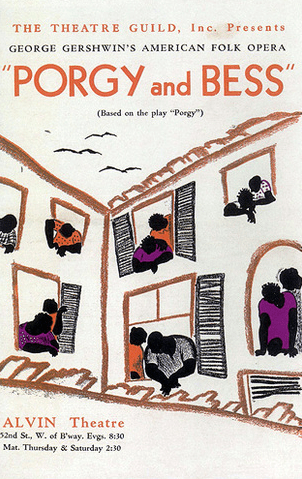In 1924, George Gershwin, a famous American composer, premiered “Rhapsody in Blue,” which became hailed as a “highbrow jazz” piece. Gershwin enjoyed taking common art, like jazz, which he thought was crude and vulgar, and make it transcend itself into a higher form of art, like he did with “Rhapsody in Blue.” This would not be his only work that elevated the music of “commoners.” In 1925, Gershwin read DuBose Heyward’s novel, Porgy, which illustrated the love story of two African Americans named Porgy, a crippled beggar, and Bess, who was addicted to drugs and was in an abusive relationship with her boyfriend, Crown. This story takes place in a black slum in South Carolina, the home state of Heyward, called Catfish Row. This novel was Heyward’s attempt to capture the folk culture of the African American community, and George Gershwin took an interest in it as well. Heyward and Gershwin wanted to present authentic African American folklore in an opera, so in the summer of 1934, they spent time on Folly Island, South Carolina in an African American community to experience its culture through its church services, revival meetings, and funerals. The duo also agreed that they would not use blackface, but instead, they would hire an all-black cast who could authentically convey the African American culture to the audience. Porgy and Bess premiered in 1935 as an operatic piece with music by George Gershwin and his brother Ira Gershwin.1 But, was the attempt of Heyward and Gershwin to convey the African American folk culture on stage accepted by the African American community as an authentic and respectful representation of their culture, or was it seen a glorified minstrel show?
Minstrel shows were a popular form of entertainment during the second half of the nineteenth century. At first, these shows were performed by an all-white cast in blackface presenting stereotypes of slave culture in a comedic sense through song, dance, and jokes. Al Jolson had a successful career in blackface and even wanted to play the part of Porgy in Porgy and Bess; however, Heyward and Gershwin wanted to steer away from blackface to produce a more authentic representation of folk culture. However, the use of an all-black cast in Porgy and Bess does not automatically dismiss its inability to be called a minstrel show. In 1865, the first all-black minstrel group, the Georgia Minstrels, gained popularity in the Northeast, and the saturation of all-black minstrel groups in America grew through the 1870s. Black minstrel groups provided more authenticity to this form of grotesque entertainment in regards to dance and music.2
To begin to answer the question of whether or not Porgy and Bess was, in fact, really a minstrel show or genuine operatic work, it is important to listen to the voices of African American critics, since it was their culture that Gershwin decided to put under the stage light. Not surprisingly, there was great criticism over the dramatic content of the play and its portrayal of African American culture. Pearl Bailey, who played Maria in Porgy and Bess, criticized certain lines from the opera saying, “I don’t care if it’s Negro, or Italian or Creek or French, it’s in bad taste,” also claiming that these particular lines were “unnatural.”3 This use of the word “unnatural” implies that Gershwin and Heyward were unable to capture the authenticity of the African American culture fully, probably because they were not of that race and ended up creating over-exaggerated elements of African American lingo. Leigh Whipper, an African American actor born in 1876, claimed that, “As a person and president of the Negro Actors Guild of America, I will not participate in any project that may prove to be derogatory to my race.”4 A. S. Young, also an African American actor, wrote to Goldwyn, the producer of the movie adaptation of Porgy and Bess, that Porgy and Bess “perpetuates old stereotypes of people that right-thinking people have buried long ago.”5

Today, Porgy and Bess is considered a classic, especially because of the musical elements, and it is still performed. Grace Bumbry, a contemporary actress of the character Bess, stated, “I thought it [the role of Bess] beneath me. I felt I had worked far too hard, that we had come far too far to have to retrogress to 1935. My way of dealing with it was to see that it was really a piece of Americana, of American history, whether we liked it or not. Whether I sing it or not, it was still going to be there.”6 Gathering from both historical and contemporary voices, Porgy and Bess has never been accepted by the African American community as an authentic or tasteful representation of their culture particularly due to the stereotypical characters created by Gershwin and Heyward. Still, regardless of the dissatisfaction it brought to the African American community, Porgy and Bess has been immortalized in today’s theatrical repertoire by its equally immortalized composer, George Gershwin. It will always be America’s first opera. Not only that, but it is American’s first opera that just so happened to be made for African Americans during the 1930s. While it is an important historical opera, Porgy and Bess will also continue to spew controversies over its racial content.
- Ray Allen, “An American Folk Opera? Triangulating Folkness, Blackness, and Americaness in Gershwin and Heyward’s Porgy and Bess,” Journal of American Folklore 117, no. 465 (2004): 243-246. ↵
- Alan Brinkley, American History: Connecting with the Past Volume 2 since 1865 (New York: McGraw-Hill Education, 2011), 420-421. ↵
- Era Bell, “Why Negros Don’t Like Porgy and Bess,” Ebony, October 1, 1959, 51.” ↵
- Era Bell, “Why Negros Don’t Like Porgy and Bess,” Ebony, October 1, 1959, 51.” ↵
- Era Bell, “Why Negros Don’t Like Porgy and Bess,” Ebony, October 1, 1959, 54. ↵
- Ben Cosgrove, “Rare Photos from the set of ‘Porgy and Bess,'” Time, February 7, 2013. http://time.com/3875928/porgy-and-bess-rare-photos-from-the-set-of-a-controversial-classic/. ↵



9 comments
Christopher Metta Bexar
All of the commentators previously to this article seem to be missing one very important point. Gershwin and Hayward wanted to create not only a show showing African American culture but utilizing African American acting.
The first African American to win an Academy Award for acting won it playing a stereotype from another era, Ms. Hattie Mac Daniels for Mammy in Gone With the Wind. There would not be a another person of African American descent be nominated or win the Oscar until the Oscars celebrating the films of 1964.
Porgy & Bess is an important event. So important that it has drawn such stars as Ella Fitzgerald, Sidney Poitier , James Earl Jones, and Leontyne Price to appear and record it. There has never been a white production of this classic.
Noah Wesolowski
I have little knowledge so this article was a very interesting read. Heyward and Gershwin showed that they wanted to produce a more traditional and cultural representation. But it was shown that they were unable to produce that traditional feel. But in the end they were able to come out with Porgy and Bess, that Porgy and Bess which later was adapted into a movie.
Indhira Mata
Before reading this article I didn’t know what a blackface was and no I understand what it is clearly in the artistic world. I like how someone from another race wanted to give the African Americans their own opera by having all actors African American in order to fulfill the authentic of the play. But I am confused in why the actors or viewers that were against it still participated in it. What was there reasoning? The article was well written by giving the comments of the people involved in the production.
Maricela Guerra
The Porgy and Bess story seems very interesting, even then actors or actresses didn’t feel like it was right to be acting in this sort of way. It seemed like it would really hard for these actors to be doing, how can someone pick whether to be part of their job and get paid. Or to just look at your morals but not be able to actually do your job.
Mariet Loredo
Great article! Before reading this I didn’t know much about Porgy and Bess, but now I know the basics about it and now I am interested in watching the opera. While reading this article I can see that Hayward and Gershwin wanted to give the African American community there own opera, showing their lives. They also wanted to break off from using blackface and use all African American actors, which I think was a great thing to do during that time period because it challenged the norm. The article also said that some of the actors believed that the opera did not capture the African American culture correctly and that it is very stereotypical. I want to watch the opera so I can form my own opinion on it.
Maalik Stansbury
To be in their shoes, taking the job doesn’t seem like the best thing to do, so i can understand their choices.However why would this role even be something to be thought about. Well different time different thought process os i can understand. I find it intriguing of how you wrote the article, the set up of it, it was well doe. I like how you explained everything in an understanding way that helped, at least, me understand. Great article.
Rachel White
I thought it was amazing that the authors Hayward and Gershwin fully immersed themselves into the African American culture for a summer and used an all black cast to achieve the effect they were attempting to portrait. I had heard very little of this opera previous to reading this article, you did a fantastic job of describing it clearly and enjoyable with the use of quotes from real people in regards to the play. You did a great job of using credible people to make these quotations with and engaged the reader with a small quotation right out of the play.
Angelica Espinoza
First of all, really well written article. I do think that if I were in the position of those actors I would most likely not have taken the job. It makes you wonder what reasoning they had for being a part of a production that they seemed to be so against. I enjoyed learning about this, I was not aware that Porgy and Bess was America’s first opera. I am also intrigued by the last sentence, because I had never heard of this opera before reading this article, and you stated it still stirs up controversy. It makes me want to watch with my friends and get their opinions on it today compared to the 1920s and 30s. Great job executing the defense of your thesis!
Celina Resendez
I enjoyed the comments included in the article from people who were involved in the various productions. I had some questions after reading this article, if the actors were so against what the show was representing, why would they even consider the role? I understand that it is a symbol in history and stands out as America’s first opera, but why would they choose to be a part of something they seem so against? I really enjoyed your article because it makes me want to learn more about the feelings and opinions of all who know the story and have seen or been involved in this show.